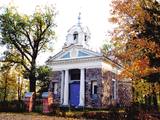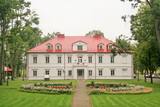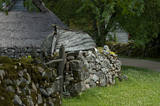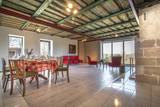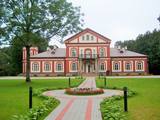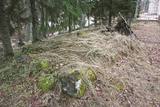| Nr | Name | Beschreibung |
|---|---|---|
|
Kulnevskaya (Ilzeskalns) Orthodox Church was built in 1832 by Kulnevs, the landlord of Ilzenberg
(Ilzeskalns) manor house. He was also the brother of Jacob Kulnevs. The Church has an iconostasis with
icons of the 19th century. The rectangular building has semicircular niches at its sides. The members of Kulnevs
family are buried here. The place of tomb is a rare phenomenon in Orthodox churches of Latvia.
|
||
|
Das Tal des Flusses Vējupīte ist für die Reisenden gedacht, die sich vor mehreren steilen Holztreppen nicht fürchten, die an den steilen Hängen des Tals führen. Wenn wir hinter dem Gästehaus Līvkalns absteigen, dann kommen wir an der flachen (3,6 m), aber hohen (6,1 m) Höhle Pētera ala (die Höhle von Peter), die einer Spalte ähnliche Nische ist. Wenn wir etwa 10 Minuten flussabwärts (Richtung Gauja) gehen, wird das linke Ufer des Flusses von dem tiefen Tal Pūču grava (Eulental) durchgespaltet, wo der Fluss Kraukļupīte (Rabenfluss) fließt. An der Stelle, wo sich die beiden Täler zusammentreffen, erhebt sich der Burgberg von Satezele (Hügelfläche 90 x 75 m), wo sich am Anfang des 13. Jhs. die Burg aus Eichenholz des Lehnsherren Dabrelis befand. Der Haupteingang war auf der westlichen Seite des Burgbergs. Von den Tiefen des Tals Pūču grava kann man zum Burgberg eine Treppe hochsteigen. Um das Tal Kraukļu aiza (Rabenschlucht) zu besichtigen, muss dieselbe Treppe herabgestiegen und der Weg Richtung Gauja genommen werden. Das Tal Kraukļu aiza ist das Seitental des linken Ufers von Vējupīte mit bis zu 11 m hohen und eindrucksvollen Sandsteinwänden, wo sich die 5,2 m tiefe Höhle Kraukļu ala (Rabenhöhle) herausgebildet hat. Wenn wir noch etwa 10 – 15 Minuten gehen (den Fluss Vējupīte auf hölzerne Brücken überqueren), kommen wir an einer Treppe, die auf den Hügel Paradīzes kalns (Paradiesberg) führt (die Beschreibung siehe vorher bei der Nr. 7). |
||
|
Saimnieki piedāvā vietu, kur aizbraukt brīvā laika pavadīšanai, atpūtā ģimenei Kurzemē. Šeit viesiem ir iespēja aplūkot sākot no dažādu laiku lauksaimniecības tehnikas un darbarīkiem, līdz pat kara laika paliekām, kā arī dažādu laiku sadzīviskos priekšmetus. Katram priekšmetam seko arī stāsti, kas ir piedzīvoti vai tikai dzirdēti. Tāpat apmeklētājiem ir iespēja apskatīt mājas iemītniekus,kas ir veidoti ar pašu rokām. Asākām un patīkamākām sajūtām pieejama 350 metrus gara Baskāju taka. |
||
|
Die Study Tours in zwei geografischen Teilen Lettlands widmen sich dem Roggenbrot - dem Symbol der Letten. Neben den Traditionen des Backens und Essens von Roggenbrot bieten sie auch einen Einblick in den Weg des Roggenkorns von der Geschichte bis in die Gegenwart, sowie Information über die Sehenswürdigkeiten und landwirtschaftliche Betriebe verschiedener Regionen. Diese Studienreise ist für Gruppen und können an jeden Kunden angepasst werden, je nach seinen Bedürfnissen, Interessen und Zeitrahmen. Touren beinhalten: Treffen mit Experten, Besuche, touristische Dienstleistungen - Unterkunft, Verpflegung, Besichtigungen, Busvermietung und Reiseleiter. Die Tour ist in Kooperation mit dem Lettischen Bäckerverband (Latvijas Maiznieku biedrība) entwickelt. |
||
|
Mit eigenem Auto oder mit dem Mietauto fahren. Diese Tour beinhaltet das Fahren, einige Wanderteile und Sie beginnen die Tour in Rīga mit ihrer wunderschönen Altstadt, die Teil des UNESCO-Kulturerbes und eines Jugendstilviertels ist. Danach fahren Sie zum Nationalpark Ķemeri, wo Sie auf dem Wald-Wanderweg bis zu der Siedlung Bigauņciems wandern, wo der Wald-Wanderweg auf den baltischen Küstenwanderweg trifft. Danach wandern Sie entlang des Waldweges im wunderschönen Abava-Flusstal und besichtigen Sabile – eine Stadt, wo Wein und Apfelwein gebrüht wird. Dann erreichen Sie die bezauberndste Stadt von Kurzeme – Kuldīga – mit den schmalen Altstadtstraßen mit Kopfsteinpflasterbelag, der Brücke über den Fluss Venta, der Uferpromenade und dem berühmten Wasserfall. Danach fahren Sie an die Küste, wo Ihre Wanderung entlang den herausragendsten Steilhängen, die man an der Küste der Ostsee finden kann, führt. Weiter gelangen Sie in die windige Stadt Liepāja und wandern im Naturpark Pape. Die Tour führt Sie weiter nach Litauen, wo sie auf dem baltischen Küstenwanderweg fortsetzt. Zuerst werden Sie die Kurstädte Palanga und Klaipėda besichtigen, und weiter führt Ihre Wanderung den Sanddünen in der Kurischen Nehrung von Pervalka nach Juodkrantė entlang. Weiter fahren Sie von Klaipėda nach Paplatelė und genießen eine 1-tägige Wanderung im Nationalpark Žemaitija. Dann fahren Sie nach Telšiai und erkunden den See Germantas und das Landschaftsschutzgebiet entlang kleiner Waldwege und Holzstege. Am Ende der Tour begeben Sie sich auf eine 1-tägige Wanderung im Regionalpark Kurtuvėnai, der eines der waldreichigsten Gebiete Mittellitauens ist. Wobei der östliche Teil des Hochlandes Žemaitija sich durch seine vergletscherten Gebiete unterscheidet. |
||
|
Eine Burgberg mit einer befestigten Vorburg wurde schon in 10 – 13 Jh. bewohnt. Am Fuße der Burg befand sich eine Stadt. In 1335 – 1347 hat der Livländische Orden auf dem Burgberg eine Steinburg aufgebaut, die im 18. Jh. vernichtet wurde. Ein Aussichtsplatz. |
||
|
Маршрут объединяет все многообразие Видземе и пролегает как вдоль морского побережья, так и по извилистым дорогам возвышенности с просторными живописными видами. Особенно подходит для семей с детьми. Информация о маршруте от Latvijas Lauku forums |
||
|
Das neu restaurierte Gutshaus, das von einem schönen Park umgeben ist und im Stile der Mitte des 19. Jh. daherkommt, befindet sich 14 km südlich von Panevėžys. Das Gutsensemble Bistrampolis besteht aus Gebäuden, die ab der zweiten Hälfte des 19. Jh. bis zu Beginn des 20. Jh. errichtet wurden: zweistöckiges Herrenhaus im klassizistischen Stil (Mitte 19. Jh.), Marstall, Eiskeller, Gärtnerhaus, Wirtschaftsgebäude. Das Gut ist von einem in der zweiten Hälfte des 19. Jh. angelegten Park im gemischten Stil mit Teichen umgeben. Im Gutspark ist der Pavillon auf dem Birutė-Hügel unweit des Gartenhauses ein besonderes Prunkstück. Der Park wird weiterhin belebt durch die neu gepflasterten Wege und die Brücken über die Teiche. |
||
|
Das Dorf Koguva an der Westküste der Insel Muhu ist ein hervorragendes Beispiel für die estnischen Bauernarchitektur. Die relativ gut erhaltenen Bauerngebäuden und Steinzaunen liegen alle unter Baudenkmalschutz. Im Museum von Muhu kann man einen ehemaligen reichen Strandhof Tooma erkundigen, der vor allem als Geburtsort des Schriftstellers Juhan Smuul bekannt. Hier sind auch eine alte Dorfschule und Textilausstellung. |
||
|
Der Weg, der nach Biksere führt, erinnert an eine schmale Bergstraße mit einem tiefen Graben eines kleinen Flusses. Der frühere Namen von Biksere war Libes muiža (auch Lybei Hoff, Lybienhoff), die heute noch erhaltenen Gebäude gehörtem dem Gutsherrn Magnus. Der neogothische Turm des Herrenhauses wird in Kunstkenner-Kreisen als architektonische Kuriosität bezeichnet. Im Herrenhaus ist der Sitz der Gemeindeverwaltung von Sarkaņi. In der ehemaligen Scheune hat der Kunstliebhaber Andris Trečaks seine Antiquitätensammlung ausgestellt. Von der Scheune aus hat man einen wunderbar weiten Blick auf die tiefer gelegene Ebene von Lubāna. |
||
|
Vannūzis (Bath) – A building of the five-building complex “Kurhaus”. During the times of the Neibāde resort, this small building used to be a bath place. In order for the guests of the resort to be able to take a dip in the sea water even in bad weather, barrels of water were delivered by horses to the bath place. |
||
|
Located by the old Daugava bed ravine, Sērene parish, Jaunjelgava region, the house "Lazdāres". The holiday home has three apartments, each with its own kitchen, bathroom and everything you need for a great stay in the countryside. As well as a party hall for up to 20 people. Located 3 km from Aizkraukle and one kilometer from the newly built highway P76, which connects Riga with Jēkabpils. Waiting for guests who want to enjoy the silence and summer in the countryside. Families with children. Reservations for a week and longer with discounts. |
||
|
Das Ensemble des Gutes Alanta im Dorf Naujasodis besteht aus einem neoklassizistischen Herrenhaus, dem Park aus dem 19. Jh. (Ulme, Linde, Birke, Eiche, Traubenkirsche), Nebengebäuden. Im Park neben dem einer italienischen Villa nicht unähnlichen Herrenhaus mit neoromanischen Zügen gibt es Alleen, 3 unregelmäßig geformte Teiche. Die Bäume sind vielfach so gepflanzt, dass sich die Stämme beim Wachsen berühren und die Bäume gemeinsam gewissermaßen einen Strauß bilden. Neben einheimischen Gehölzen fehlt es auch nicht an exotischen. An der Grenze des Parks steht ein Altan mit Gitterwänden, ein mehrere Meter hoher weißer Obelisk und näher am Herrenhaus Marmorskulpturen von Venus und Jupiter. |
||
|
Diese Grabstätte ist ein mit Sagen und Spukgeschichten umwobener Ort, der sich auf dem Hügel des alten Friedhofs an der Kirche von Mazirbe befindet. Die Grabstätte ist mit Steinen bedeckt und soll die einzige in Lettland bekannte Grabstätte eines Werwolfs sein. |
||
|
Die Reiseroute von Riga nach Tallinn verbindet Natur-, Kultur- und kulinarische Aspekte und umfasst 15 Naturpfade, Moore, Wiesen und Wälder entlang der Ostseeküsten Lettlands und Estlands. Sie führt Sie direkt dorthin, wo regionale Spezialitäten hergestellt werden, damit Sie sie frisch und unverfälscht genießen können. Sie werden erleben, wie Neunaugen auf einem Grill für Sie zubereitet werden, leckeres hausgemachtes Eis probieren, geräuchertes Fleisch auf Bauernhöfen und vieles andere mehr verkosten. Am Ende der Reise werden Sie ein echter Experte der traditionellen und der modernen lettischen und estnischen Küche sein! Da sich die Bauernhöfe, die Lebensmittel produzieren, oft in wunderschönen Naturlandschaften befinden, kombinieren Sie auf dieser Tour Kulinarisches auch gleich mit Erholung. Es gibt viele Naturpfade, an denen Aussichtstürme zur Vogelbeobachtung stehen. Auf den Randu-Wiesen bei Ainaži findet sich ein Drittel der gesamten in Lettland vorkommenden Pflanzenarten. Ein Holzweg führt durch Schilf zu einer Aussichtsplattform mit Blick auf Wiesen und Ostsee. Flora und Fauna der Insel Saaremaa unterscheiden sich sehr von jenen auf dem Festland. Den Besucher erwarten hier eine Kalkstein-Steilküste, ausgedehnte Wacholderheiden, Meteoritenkrater und Orchideenwiesen. Die Tour führt vorbei an Bauernhöfen und durch Dörfer, wie sie typisch für die Küstengebiete Estlands sind. Die Insel Hiiumaa ist ein besonders ruhiger Ort; eine typisch estnische, ländliche Atmosphäre hat sich hier bewahrt. Ausflugsziele sind die bedeutenden Vogelschutzgebiete an den Boddengewässern von Käina, die Landzunge Sääre Tirp und die vielen kleinen Inseln vor der Südostküste. Auf dem estnischen Festland gewährt die Pakri-Halbinsel bei Paldiski mit ihrer ehemaligen sowjetischen Marine-Militärbasis einen Einblick in die jüngere Geschichte des Landes. |
||
|
Die Käserei von Rauna gehört der Familie Ceriņš, die schon 10 Jahre den Käufern 23 qualitative und hochwertige Produkte – Käse, Butter und Röhrennudeln anbietet. Das beliebteste Erzeugnis der Käserei ist der Käse „Zaļais”. Einer der Hauptinhaltsstoffe dieses Produkts ist der Käseklee, der in eigenem Garten angepflanzt wird. Der Käseklee ist eine einjährige krautige Pflanze. Geerntet werden die grünen oberirdischen Pflanzenteile, die in einem mit Holz beheizten Trockner getrocknet werden. Nach dem Abtrocknen werden die Pflanzenteile gemahlen, durchgesiebt und einer Eiweißmasse zugesetzt. Diese Masse wird dünnschichtig in die extra angefertigten Holzkasten geschüttet und getrocknet. Nach der Anfügung des Käseklees erhielt das Produkt ein ausgeprägter Geschmack, Duft und Farbe des Käse „Zaļais”. Nach vorheriger Vereinbarung können die Gruppen (min. 10 Personen) die Käserei besichtigen und mit einem bekanntmachen. |
||
|
Sie erhielt ihre Bezeichnung von dem Fischmarkt, der sich früher am Ende der Straße beim Kuršu laukums (Platz der Kurši) befand. Im Hof der Zivju iela 4/6 und im Hof der anliegenden Peldu iela 2 sind bis heute die alten Lagergebäude in Holzblockhaus-Bauweise erhalten. In der Zivju iela befindet sich auch eins der beliebtesten Besichtigungsobjekte – die Ruhmesallee lettischer Musiker (seit 2006). Auf Bronzeplatten sind die Handabdrücke 50 lettischer Musiker zu sehen, 10 Platten sind populären Musikgruppen gewidmet, 5 Platten bereits verstorbenen Musikern. Hier steht auch die größte Gitarre Lettlands. |
||
|
Ļoti skaists un ainavisks etnogrāfiskais ciems Balošas (Baluošas) ezera ziemeļu krastā, netālu no diviem iepriekš minētajiem ciemiem. Te apskatāmas interesantas un skaistas koka ēkas, kas celtas no guļbaļķiem, ar niedru vai lubiņu jumtiem un izrotātas ar dažāda veida dekoratīvajiem elementiem. Pirmo reizi rakstos Šumini minēti 1784. g. Savu vārdu ciems ieguva no kādreiz dzīvojošas ģimenes uzvārda. Kā interesantākā ir jāpiemin sena klēts. |
||
|
Piemājas saimniecība nodarbojas ar augļkopību un biškopību! |
||
|
Die Kirche hat einen 1800 gebauten einzigartigen achteckigen Glockenturm. Blick auf den Lūšiai-See. |
||
